Get Customer Preference
1. getCustomerPreference.cs
These four packages are required to be used.

Step 1. Create class file to store content of the web response.
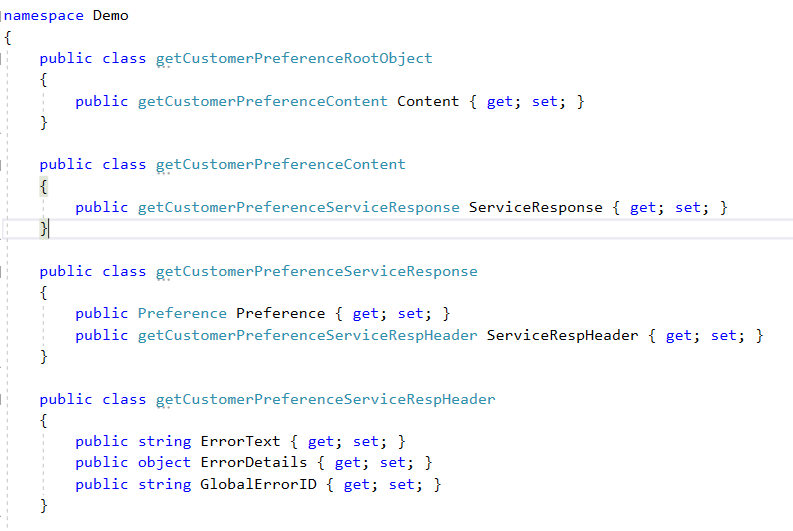
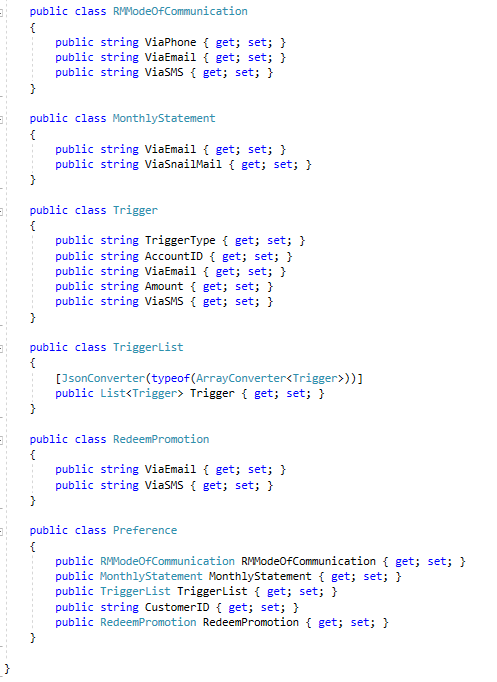
2. getCustomerPreference.aspx.cs
These 15 packages are required to be used.
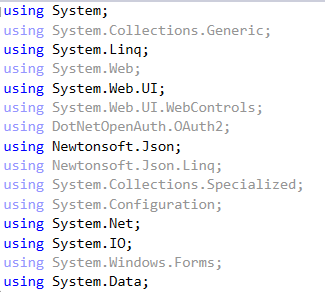
Code in Common
(1). Check if user id and password is inside session. When the user id and password is inside user session, it will automatically populate into the user id and pin textbox, so that the user need not manually type his user id and password repeatedly.
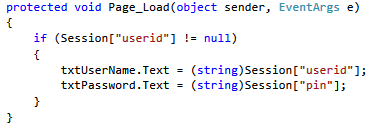
Step 2. Store details entered by the user. If user id, password, and OTP exist in session, user need not enter again (refer to common stuff).
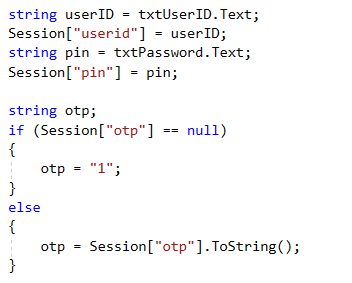
Step 3. Create URL which will be post to the server. User inputs need to be stored in the class created, and serialize into JSON format. In this function, only header is needed.

Step 4. Post to the server, and store response. URL is sent using web request function, and a response will be send back from the server. The response need to be deserialized into the ‘getCustomerPreference’ class.
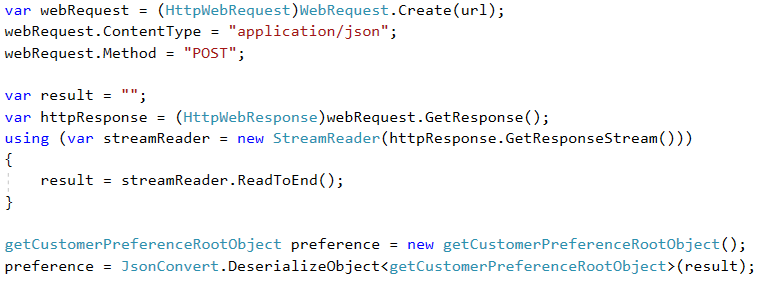
Step 5. Obtain error code. If error code is ‘010000’ which means invocation successful, populate attributes of the ‘getCustomerPreference’ class into the Label and Gridview. If error code is '010041', it means OTP has expired, and we will use the newOTP() function to prompt the user for the OTP again. Else, we will display the ErrorText and ErrorDetails.
The newOTP() function can be referred to under Common Stuff Section
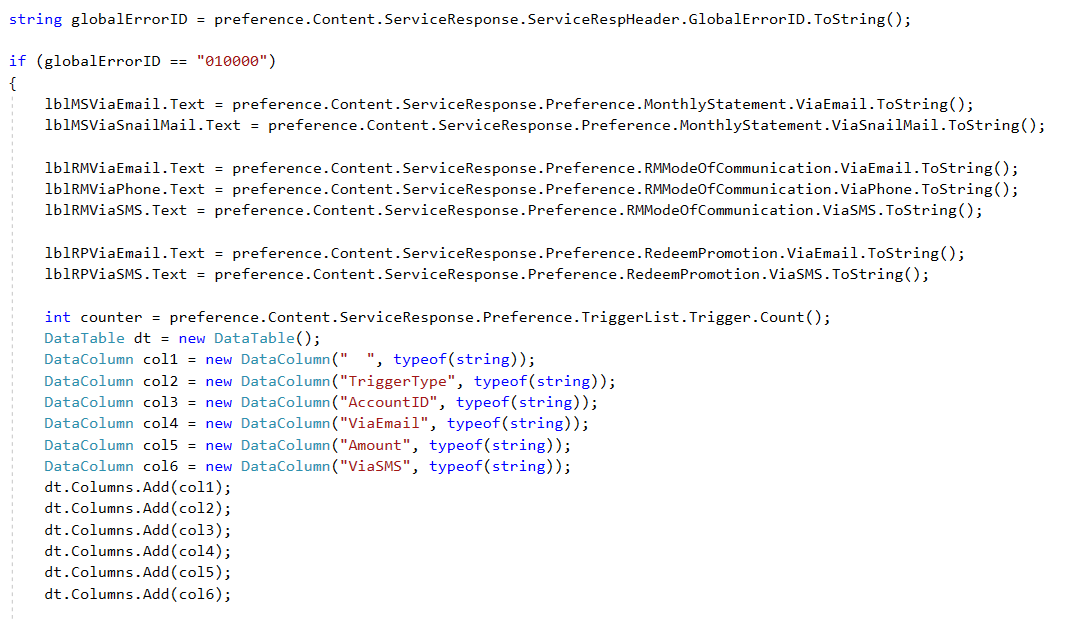
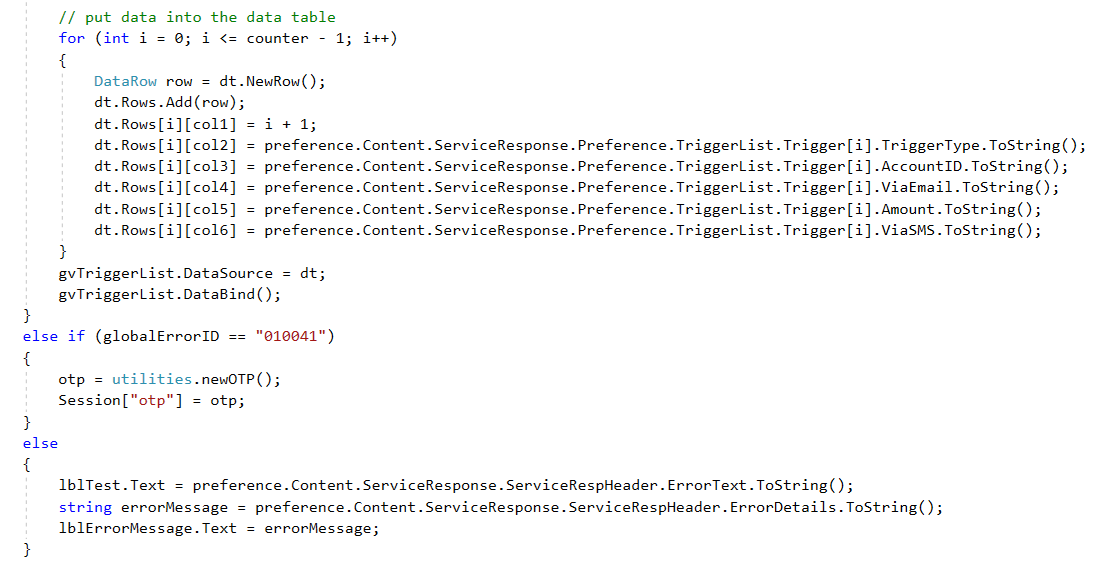
Overview of getCustomerPreference.cs
using System;
using System.Collections.Generic;
using System.Linq;
using System.Web;
using System.Web.UI;
using System.Web.UI.WebControls;
using DotNetOpenAuth.OAuth2;
using Newtonsoft.Json;
using Newtonsoft.Json.Linq;
using System.Collections.Specialized;
using System.Configuration;
using System.Net;
using System.IO;
using System.Data;
using Microsoft.VisualBasic;
namespace Demo
{
public class getCustomerPreferenceRootObject
{
public getCustomerPreferenceContent Content { get; set; }
}
public class getCustomerPreferenceContent
{
public getCustomerPreferenceServiceResponse ServiceResponse { get; set; }
}
public class getCustomerPreferenceServiceResponse
{
public Preference Preference { get; set; }
public getCustomerPreferenceServiceRespHeader ServiceRespHeader { get; set; }
}
public class getCustomerPreferenceServiceRespHeader
{
public string ErrorText { get; set; }
public object ErrorDetails { get; set; }
public string GlobalErrorID { get; set; }
}
public class RMModeOfCommunication
{
public string ViaPhone { get; set; }
public string ViaEmail { get; set; }
public string ViaSMS { get; set; }
}
public class MonthlyStatement
{
public string ViaEmail { get; set; }
public string ViaSnailMail { get; set; }
}
public class Trigger
{
public string TriggerType { get; set; }
public string AccountID { get; set; }
public string ViaEmail { get; set; }
public string Amount { get; set; }
public string ViaSMS { get; set; }
}
public class TriggerList
{
[JsonConverter(typeof(ArrayConverter<Trigger>))]
public List<Trigger> Trigger { get; set; }
}
public class RedeemPromotion
{
public string ViaEmail { get; set; }
public string ViaSMS { get; set; }
}
public class Preference
{
public RMModeOfCommunication RMModeOfCommunication { get; set; }
public MonthlyStatement MonthlyStatement { get; set; }
public TriggerList TriggerList { get; set; }
public string CustomerID { get; set; }
public RedeemPromotion RedeemPromotion { get; set; }
}
}
Overview of getCustomerPreference.aspx.cs
using System;
using System.Collections.Generic;
using System.Linq;
using System.Web;
using System.Web.UI;
using System.Web.UI.WebControls;
using DotNetOpenAuth.OAuth2;
using Newtonsoft.Json;
using Newtonsoft.Json.Linq;
using System.Collections.Specialized;
using System.Configuration;
using System.Net;
using System.IO;
using System.Data;
using System.Windows.Forms;
namespace Demo
{
public partial class GetCustomerPreference : System.Web.UI.Page
{
protected void Page_Load(object sender, EventArgs e)
{
if (Session["userid"] != null)
{
txtUserID.Text = (string)Session["userid"];
txtPassword.Text = (string)Session["pin"];
}
}
protected void btnSend_Click(object sender, EventArgs e)
{
if (Page.IsValid)
{
try
{
gvTriggerList.DataSource = null;
gvTriggerList.DataBind();
string userID = txtUserID.Text;
Session["userid"] = userID;
string pin = txtPassword.Text;
Session["pin"] = pin;
string otp;
if (Session["otp"] == null)
{
otp = "1";
}
else
{
otp = Session["otp"].ToString();
}
var header = new HeaderJson();
header.userID = userID;
header.PIN = pin;
header.serviceName = "getCustomerPreference";
header.OTP = otp;
var headerJson = new HeaderJsonObject();
headerJson.Header = header;
string strHeader = JsonConvert.SerializeObject(headerJson);
string url = "http://tbankonline.com/SMUtBank_API/Gateway?Header=" + strHeader;
var webRequest = (HttpWebRequest)WebRequest.Create(url);
webRequest.ContentType = "application/json";
webRequest.Method = "POST";
var result = "";
var httpResponse = (HttpWebResponse)webRequest.GetResponse();
using (var streamReader = new StreamReader(httpResponse.GetResponseStream()))
{
result = streamReader.ReadToEnd();
}
getCustomerPreferenceRootObject preference = new getCustomerPreferenceRootObject();
preference = JsonConvert.DeserializeObject<getCustomerPreferenceRootObject>(result);
string globalErrorID = preference.Content.ServiceResponse.ServiceRespHeader.GlobalErrorID.ToString();
if (globalErrorID == "010000")
{
lblMSViaEmail.Text = preference.Content.ServiceResponse.Preference.MonthlyStatement.ViaEmail.ToString();
lblMSViaSnailMail.Text = preference.Content.ServiceResponse.Preference.MonthlyStatement.ViaSnailMail.ToString();
lblRMViaEmail.Text = preference.Content.ServiceResponse.Preference.RMModeOfCommunication.ViaEmail.ToString();
lblRMViaPhone.Text = preference.Content.ServiceResponse.Preference.RMModeOfCommunication.ViaPhone.ToString();
lblRMViaSMS.Text = preference.Content.ServiceResponse.Preference.RMModeOfCommunication.ViaSMS.ToString();
lblRPViaEmail.Text = preference.Content.ServiceResponse.Preference.RedeemPromotion.ViaEmail.ToString();
lblRPViaSMS.Text = preference.Content.ServiceResponse.Preference.RedeemPromotion.ViaSMS.ToString();
int counter = preference.Content.ServiceResponse.Preference.TriggerList.Trigger.Count();
DataTable dt = new DataTable();
DataColumn col1 = new DataColumn(" ", typeof(string));
DataColumn col2 = new DataColumn("TriggerType", typeof(string));
DataColumn col3 = new DataColumn("AccountID", typeof(string));
DataColumn col4 = new DataColumn("ViaEmail", typeof(string));
DataColumn col5 = new DataColumn("Amount", typeof(string));
DataColumn col6 = new DataColumn("ViaSMS", typeof(string));
dt.Columns.Add(col1);
dt.Columns.Add(col2);
dt.Columns.Add(col3);
dt.Columns.Add(col4);
dt.Columns.Add(col5);
dt.Columns.Add(col6);
// put data into the data table
for (int i = 0; i <= counter - 1; i++)
{
DataRow row = dt.NewRow();
dt.Rows.Add(row);
dt.Rows[i][col1] = i + 1;
dt.Rows[i][col2] = preference.Content.ServiceResponse.Preference.TriggerList.Trigger[i].TriggerType.ToString();
dt.Rows[i][col3] = preference.Content.ServiceResponse.Preference.TriggerList.Trigger[i].AccountID.ToString();
dt.Rows[i][col4] = preference.Content.ServiceResponse.Preference.TriggerList.Trigger[i].ViaEmail.ToString();
dt.Rows[i][col5] = preference.Content.ServiceResponse.Preference.TriggerList.Trigger[i].Amount.ToString();
dt.Rows[i][col6] = preference.Content.ServiceResponse.Preference.TriggerList.Trigger[i].ViaSMS.ToString();
}
gvTriggerList.DataSource = dt;
gvTriggerList.DataBind();
}
else if (globalErrorID == "010041")
{
otp = utilities.newOTP();
Session["otp"] = otp;
}
else
{
lblTest.Text = preference.Content.ServiceResponse.ServiceRespHeader.ErrorText.ToString();
string errorMessage = preference.Content.ServiceResponse.ServiceRespHeader.ErrorDetails.ToString();
lblErrorMessage.Text = errorMessage;
}
}
catch (Exception ex)
{
lblExceptionMsg.Text = ex.ToString();
}
}
}
}
}
Created with the Personal Edition of HelpNDoc: Full-featured EPub generator